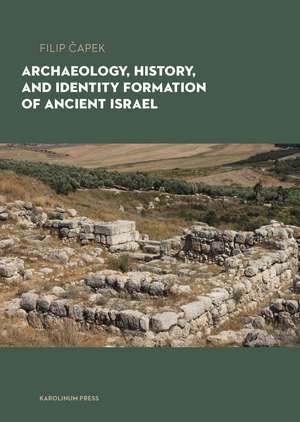Archaeology, History, and Formation of Identity in Ancient Israel
Autor Filip Capek Traducere de Václav Koutnýen Limba Engleză Paperback – 28 ian 2025
When did Israel begin? The origins of ancient Israel are shrouded in mystery, and those hoping to explore the issue must utilize resources from three different fields—archaeology, epigraphy, and biblical texts—and then examine their interrelations while keeping in mind that the name Israel was not used to describe just one state but referred to numerous entities at different times.
Archaeology, History, and Formation of Identity in Ancient Israel provides a critical reading of Israel’s history. It is neither a harmonizing reading, which takes the picture painted by texts as a given fact, nor a reading supporting biblical texts with archaeological and epigraphic data; instead, it offers the reader multiple options to understand biblical narratives on a historical and theological level. In addition to presenting the main currents in the field, the book draws upon the latest discoveries from Czech-Israeli excavations to offer new hypotheses and reconstructions based on the interdisciplinary dialogue between biblical studies, archaeology, and history.
Preț: 174.85 lei
Preț vechi: 215.22 lei
-19% Nou
Puncte Express: 262
Preț estimativ în valută:
33.46€ • 34.93$ • 27.69£
33.46€ • 34.93$ • 27.69£
Carte nepublicată încă
Doresc să fiu notificat când acest titlu va fi disponibil:
Se trimite...
Preluare comenzi: 021 569.72.76
Specificații
ISBN-13: 9788024654171
ISBN-10: 8024654172
Pagini: 355
Ilustrații: 27 color plates, 1 halftone, 38 maps
Dimensiuni: 165 x 235 x 15 mm
Greutate: 0.4 kg
Editura: Karolinum Press, Charles University
Colecția Karolinum Press, Charles University
ISBN-10: 8024654172
Pagini: 355
Ilustrații: 27 color plates, 1 halftone, 38 maps
Dimensiuni: 165 x 235 x 15 mm
Greutate: 0.4 kg
Editura: Karolinum Press, Charles University
Colecția Karolinum Press, Charles University
Notă biografică
Filip Čapek is professor of Old Testament studies at Charles University and a research fellow at the Czech Academy of Sciences’ Centre for Biblical Studies. He is the coordinator for Czech archaeological excavations at Tel Azekah and Tel Moza, Israel. Václav Koutný is a Prague-based interpreter and translator. He also teaches Latin and English at Charles University.
Cuprins
I. INTRODUCTION
II. ORIGINS (LATE BRONZE AGE TO LATE IRON AGE I)
III. DIFFICULT TENTH CENTURY (LATE IRON AGE I TO IRON AGE IIA)
IV. THE FIRST TRUE UNIFICATION AND THE FIRST TRUE DIVISION (IRON AGES IIA–B)
V. FIRST INDEPENDENCE (IRON AGES IIB–C)
VI. THE LAST LONG CENTURY (IRON AGE IIC)
VII. THE END AND A NEW BEGINNING (NEO-BABYLONIAN AND PERSIAN PERIODS)
VIII. CONCLUSIONS
IX. DIAGRAMS, MAPS, AND GRAPHS
X. ABBREVIATIONS
XI. BIBLIOGRAPHY
XII. BIBLICAL QUOTATIONS
XIII. INDEX
II. ORIGINS (LATE BRONZE AGE TO LATE IRON AGE I)
III. DIFFICULT TENTH CENTURY (LATE IRON AGE I TO IRON AGE IIA)
IV. THE FIRST TRUE UNIFICATION AND THE FIRST TRUE DIVISION (IRON AGES IIA–B)
V. FIRST INDEPENDENCE (IRON AGES IIB–C)
VI. THE LAST LONG CENTURY (IRON AGE IIC)
VII. THE END AND A NEW BEGINNING (NEO-BABYLONIAN AND PERSIAN PERIODS)
VIII. CONCLUSIONS
IX. DIAGRAMS, MAPS, AND GRAPHS
X. ABBREVIATIONS
XI. BIBLIOGRAPHY
XII. BIBLICAL QUOTATIONS
XIII. INDEX
